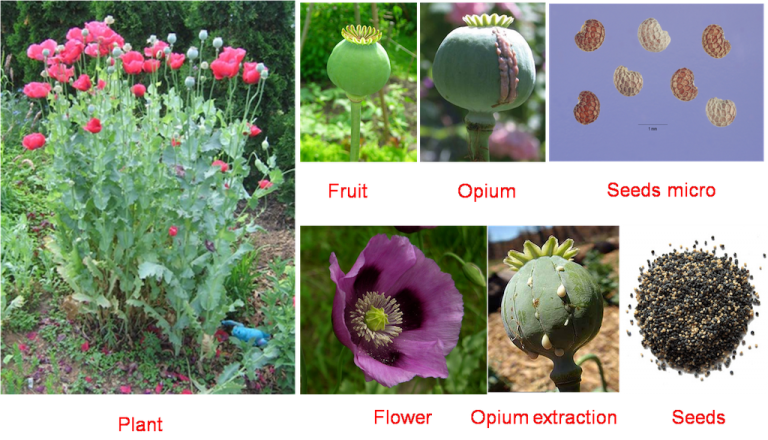AHIPHENA
- Home / DRAVYAGUNA (AYURVEDIC PHARMACOLOGY) / / KNOW ABOUT MEDICINAL PLANTS / / AYURVEDIC MEDICINAL PLANTS /
- AHIPHENA
The plant Ahiphena is the one that is native to Asia and is cultivated in a very legally controlled environment. There are many derivatives that is being used in the Modern science for its anti-inflammatory activity. The class of drugs that are derived from this plant alkaloids are known as OPOID drugs. Among them Morphine is an important alkaloid which is used to have a relief from a pain of high intensity. In Ayurveda the plant is having its own prominence where it is also present in the list of UPAVISHA. The use of this plant is in many of the formulations mentioned in classical texts of Ayurveda. Ahiphena is an important product that is obtained from the raw fruits of the plant which is used in many of the medicinal systems. The botanical name of the plant is Papaver somniferum L. The name Papaver is derived from the word that is derived and reduplicated from latin name pap which means to swell. While somniferum denotes the effect of the plant that is ‘the ability to induce sleep’.
PLANT DETAILS
BOTANICAL NAME
Papaver somniferum L
FAMILY
Papaveraceae
NOMENCLATURE
VERNACULAR NAMES
- Kannada – Apheem Seeds (Gasagase)
- Malayalam – Afium, Avin
- Tamil – Gashagasha
- Telugu – Gasagasalu
- Hindi – Afimaphim
- English – Opium Poppy Seeds – Poppy Seeds
SANSKRIT SYNONYMS
- निर्यास (Niryasa) – An exudate obtained from the plant
- खसफलक्षीर (Khasaphalaksheera), खसफलोद्भव (Khakasaphalodbhava) – The milky exudate obtained from fruits
- अहिफेन (Ahiphena) – a saliva or venom of snake
- तिलभेद (Tilabheda), खसतिल (Khasatila) – the seeds are similar to that of Tila or Sesamum.
- सूक्ष्मबीज (Sukshmabeeja) – Small seeds
- सूक्ष्मतणडुल (Sukshmatandula) – Stigmatic rays are present over the fruits
- सुबीज (Subeeja) – Seeds that are good for health
BRIEF MORPHOLOGY
An annual glabrous herb grows upto 4 to 5 feet height. Leaves oblong, amplexicaul with dentate lobes, alternate. Inflorescence is solitary with white, purple or red flowers. Fruit is a capsule which is 2.5 cms in diameter with glabrous 5-12 stigmatic rays above, seeds are white or black. The latex or milky juice of immature or raw fruit is collected as droplets and dried to prepare opium while the seeds are known as Khaskhas.
PHARMACOGNOSY OF OFFICIAL PART
MACROSCOPY
YET TO BE COMPILED
MICROSCOPY
YET TO BE COMPILED
PART USED AND POSOLOGY
PART USED
फलनिर्यास (Milky juice of immature fruit), फल (Fruits), बीज (Seeds) & बीज तैल (Seed oil)
DOSE
Exudate – 10 to 15 mg
PHYTOCHEMISTRY
The plant contains Morphine, Coderine, Narcottine, Nardin, Pseudomorphine, Codamine, Protophine, etc as primary alkaloids. There is apomorphine, Thebamine, Apododeine, Catarnine, etc as secondary alkaloids. Other than this it also contains lactic acid, glucose, fat, volatile oils, calcium, magnesium etc.
रसपञ्चक कर्म PROPERTIES AND USES AS PER AYURVEDA
गुण (Properties)
- रस (Rasa) – तिक्त (Tikta), कषाय (Kashaya)
- गुण (Guna) – सूक्ष्म (Sukshma), रूक्ष (Ruksha)
- वीर्य (Veerya) – उष्ण (Ushna)
- विपाक (Vipaka) – कटु (Katu)
- प्रभाव – NONE
कर्म & प्रयोग (Action & Indications)
- दोषकर्म (Doshakarma) – कफवातशामक (Kaphavatashamaka) & पित्तल (Pittala)
- धातुकर्म & मलकर्म (Dhatukarma and Malakarma) – Main actions – मादक, स्तम्भन, वेदनस्थापन, स्वेदन, स्वापजनन, ग्राहि, रुच्य (Madaka, Sthambhana, Vedanasthapana, Swedana, Swapajanana, Grahi, Ruchya)
- Other Actions – शुक्रस्थम्भक, शूलप्रशमन, कासहर, श्वासहर, धातुशोषक, ज्वरघ्न (Shukrasthambhana, Shulaprashamana, Kasahara, Shwasahara, Dhatushoshaka, Jwaraghna)
- प्रयोग (Prayoga) – Mainly वेदनयुक्त विकार, निद्रनाश, अपस्मार, विसूचिक, शोथ (Vedanayukta Vatavikara, Nidranasha, Apasmara, Vishuchika, Shotha), also useful in ज्वर, अर्श, नेत्ररोग, कर्णरोग, शोथवेदन (Jwara, Arsha, Netraroga, Karnaroga, Visuchika, Shotha)
AYURVEDIC FORMULATIONS
CLASSICAL
- अहिफेनासव
- कामिनीविद्रावण रस
- कर्पूरासव
- दुग्ध वटि
- निद्रोदय वटी
PROPRIETARY
- NONE OBSERVED
AGRONOMY
ENVIRONMENT
Being a highly sensitive plant, it is easily affected by the forces of nature like temperature, dampness, rains and wind along with humidity. The plant best grows in a low humid with maximum temperature of 20 to 25 deg C.
CULTIVATION
The propagation of the plant is done through the seeds. The quantity is usually around 5 to 7 kgs depending on the method of sowing. It results in a density of around 1.2 lakh plants in one acre. The soil required is sandy loamy, well drained and with good aeration. The best time for sowing is November.
HARVESTING
Harvesting of opium is done by the process of lancing. Here the superficial layer of the mature capsule wall is incised by using an instrument “Nastar”. This results in the oozing out of the latex. The latex is allowed to coagulate and remain the whole night which is collected by using a blunt scoop the next morning. Usually 3-4 incisions are put on the capsule. For obtaining the seeds, the dried capsules are threshed. The husk is also used to extract alkaloids.
STORAGE
Around 0.05mg of opium is obtained from each capsule and around 1.5 to 6 kg of Opium and around 120 to 160 kgs of seed is harvested fro m1 acre. The collected opium is kneaded into 500mg to 1000mg cakes. This is stored in plastic, earthen or copper vessels.
VARIETIES AND SUBSTITUTES OR ADULTERANTS
VARIETIES
As per text of Dravyaguna Vignyana by VM Gogte, there are three varieties based on flower colour. They are
- Khaskhas – Yellowish white flower and seed is white
- Khaskhas mansoor – Both flower and seed are red
- Khaskhas black – Both flower and seeds are black or blue.
As per the text Dravyaguna Vignyana by Dr Gyanendra Pandey, there are 4 types mentioned in the classical texts (NIGHANTUS). They are
- Shweta – White flowered
- Peeta – Yellow flowered
- Krishna – Black flowered
- Chitra – Multiple colour flowered.
ADULTERANTS
Opium is adulterated with materials like Arsenic, strychnine and also lead as per the recent research.
SUBSTITUTES
No substitutes for this plant
TOXICITY
TOXIC SYMPTOMS
The toxic symptoms include
- Drowsiness, Sleep, Unconsciousness, dyspnea, depression and death.
- The symptoms manifest in 3 stages namely
- Stage of Excitement – increased sensation of well being, freedom from anxiety, etc
- Stage of Stupor – Headache, nausea, vomiting, giddiness, face and lips cyanosis, etc
- Stage of Narcosis – Deep coma, loss of sensation or reflex, pale face, drop of lower jaw, increased perspiration, Slow of pulse, Pupils contracted to pinpoint, slow of respiration and death
ANTIDOTE
- Stomach wash using water mixed with Arishtaka (Sapindus trifoliatus) or Sarshapa (Brassica campestris).
- Suitable Antidotes
- Stimulants and Cardiotonics
- Avoid sleeping till the toxicity decreases
- Specific Antidote – Nalorphie hydrobromide or Naloxone hydrochloride
शोधन or PURIFICATION METHOD
- Opium is given Bhavana (Infusion or impregnation) with the fresh juice of Ardraka (Zingiber officinale) for 21 times will result in its purification.
THERAPEUTIC USES
EXTERNAL USES –
Application of the exudate on the parts where there is inflammation and pain will result in decrease of pain and inflammation. It is also useful in the treatment of painful joints , pleurisy through external application.
INTERNAL USES –
Preparations of the plant is administered in low doses to treat Abdominal colic, Depression, Premature ejaculation, Neuralgia and other neural diseases. It is also administered in epilepsy as an anticonvulsant.
Seeds are non-poisonous nor have any narcotic effect. It is used in many curry preparations as spice and also in the preparation of sweets and condiments.
CONTROVERSY (IF PRESENT)
YET TO BE COMPILED
LIST OF RESEARCH STUDIES
- Alinejad S, Aaseth J, Abdollahi M, Hassanian-Moghaddam H, Mehrpour O. Clinical Aspects of Opium Adulterated with Lead in Iran: A Review. Basic Clin Pharmacol Toxicol. 2018 Jan;122(1):56-64. doi: 10.1111/bcpt.12855. Epub 2017 Oct 18. PMID: 28802093.
- Datta DV. Arsenic adulteration in opium. (Arsenicosis–a real danger to health in developing countries). J Assoc Physicians India. 1978 Apr;26(4):223-7. PMID: 730693.
- A.R.L. Wijesekera, K.D. Henry, P. Ranasinghe. The detection and estimation of (A) arsenic in opium, and (B) strychnine in opium and heroin, as a means of identification of their respective sources. Forensic Science International. Volume 36, Issues 3–4. 1988. Pages 193-209,
The video on AHIPHENA emphasises on the various aspects of the plant especially with respect to its cultivation and its characteristics for identification such that they are preserved for the future generations. But the cultivation practice is legally controlled and is to be licensed by the Government.



